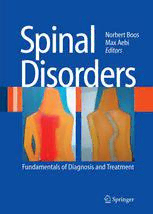
Spinal Disorders: Fundamentals of Diagnosis and Treatment PDF
Preview Spinal Disorders: Fundamentals of Diagnosis and Treatment
NorbertBoos·MaxAebi(Editors) SpinalDisorders FundamentalsofDiagnosisandTreatment NorbertBoos·MaxAebi(Editors) Spinal Disorders Fundamentals of Diagnosis and Treatment With274Figuresin1290Parts and190Tables Prof.Dr.NorbertBoos ZentrumfürWirbelsäulen-undRückenmarkchirurgie UniversitätZürich UniversitätsklinikBalgrist Forchstraße340,8008Zürich Switzerland Prof.Dr.MaxAebi InstitutfürEvaluativeForschunginOrthopädischerChirurgie MEMForschungszentrum,UniversitätBern Stauffacherstraße78,3014Bern Switzerland ISBN978-3-540-40511-5 Springer-VerlagBerlinHeidelbergNewYork LibraryofCongressControlNumber:2006927571 ˇ 2008Springer-VerlagBerlinHeidelberg Thisworkissubjecttocopyright.Allrightsarereserved,whetherthewholeorpartofthe materialisconcerned,specificallytherightsoftranslation,reprinting,reuseofillustrations, recitation,broadcasting,reproductiononmicrofilmorinanyotherway,andstorageindata banks.Duplicationofthispublicationorpartsthereofispermittedonlyundertheprovisions oftheGermanCopyrightLawofSeptember9,1965,initscurrentversion,andpermissionfor usemustalwaysbeobtainedfromSpringer-Verlag.Violationsareliabletoprosecutionunder theGermanCopyrightLaw. PrintedinGermany Theuseofgeneraldescriptivenames,registerednames,trademarks,etc.inthispublication doesnotimply,evenintheabsenceofaspecificstatement,thatsuchnamesareexemptfrom therelevantprotectivelawsandregulationsandthereforefreeforgeneraluse. Productliability:Thepublisherscannotguaranteetheaccuracyofanyinformationabout dosageandapplicationcontainedinthisbook.Ineveryindividualcasetheusermustcheck suchinformationbyconsultingtherelevantliterature. Coverdesign:eStudioCalamar,Spain Illustrations:AlainBlank,Zürich,Switzerland Printedonacid-freepaper 987654321 springer.com Dedication ToChrista,Anna,LisaandSarah N.B. ToChristine,EvaandSamuel M.A. Fortheirlove,understanding,encouragementandtolerance, withoutwhichthisbookwouldnothavebeenpossible VII Foreword FormFollowsFunction Congratulations to the editors and authors on a truly outstanding book. Most booksrecapitulatewhatmanyalreadyknow,andleaveoneseekingmore.This bookisuniqueinitscontentandformat.“Formfollowsfunction”,popularized by the great American architect Frank Lloyd Wright, is a principle associated with modern architecture and industrial design in the 20th century. Simply stated,theshapeofabuildingorobjectshouldbepredicatedbyorbaseduponits intended function or purpose. Like this phrase there is often a history that is importanttorecognizeandunderstandifwearetotrulyunderstanditsmeaning. The origin of the phrase “Form follows function” can be traced back to the AmericansculptorHoratioGreenough,butitwasAmericanarchitecturalgiant LouisSullivanwhoadopteditandmadeitfamous.Sullivanactuallysaid,“form everfollowsfunction”,butthesimpler(andlessemphatic)phraseistheoneusu- ally remembered. Sullivan’s student and assistant Frank Lloyd Wright adopted this principle in slightly different form – perhaps because shaking off the old stylesgavethemmorefreedomandlatitude. Drs.BoosandAebihaveadoptedaparticularform,inthisbook,inorderto givethereaderathoroughgroundinginthebasicknowledgeandgeneralprinci- plesofspinaldisorders.Thedidacticconcept(form)ofallthechaptersisbased onaconsistentstyleandlayout,andfollowsthreebasicprinciplesofsustainable learning (functions), i.e.: (1) less is more, (2) repetition enhances sustained learning,and(3)casestudiesareanefficientandcomplementarymeansoflearn- ing. Thebookutilizeslearningaidstohighlightandrepeatcoremessagesthrough- outallchapters,andvisualaidsfacilitatearepetition-basedlearningapproach, startingwiththecoremessages,leadingtoanin-depthreadingofeachchapter. Marginalnotesallowforeffectiverepetitionofmaterialtofacilitatethelearning process,andoutstandinggraphicswithpictorialandanecdotallearningmeth- odsareusedtocomplementthemanydetailedcasestudiestoexemplifythecore messages.Finally,theuseofimportantreferencesandlandmarkarticlesmakes thisaprizedbookforeveryone’sshelf. Congratulations to Norbert and Max on a fantastic contribution. This book will help those most in need, our patients. “Form and function” are the most importantoutcomesofthiswork,especiallyforthoseofuswhoworkeverydayto careforpeoplewiththesevariousspinaldisorders.Thankyou. JamesN.Weinstein Director,TheDartmouthInstituteforHealthPolicyandClinicalPractice Professor&Chairman,TheDepartmentofOrthopaedics Editor-in-Chief–Spine DartmouthCollegeandMedicalSchool DartmouthHitchcockMedicalCenter Lebanon,NewHampshire,USA IX Foreword DinosaurorStateoftheArt? Long ago, medical observations, advances, innovations and reviews were first presentedatmeetingsandpublishedinbooks.Withtheintroductionofscientific medicaljournals,twothingshappened.Firstpublicationtimewascutdowndra- matically compared to books and dissemination of knowledge became faster. Secondlyanewapproachtoscientificpublicationwasintroducedintheformof peerreview.Thisagainlengthenedpublicationtime,yetbenefitedquality.Some argued that scientific journals would herald the slow death of books. History provedthemwrong. Theadventoftheinternetagainmixedupallthecards.Wouldscientificjour- nalssurvivetheinternet?Initiallythepeerreviewaspectwaslostandthequality of available knowledge suffered. Yet, sites like Wikipedia introduced the very conceptofpeerreviewonline.So,wouldtheinternetkillpeerreviewjournalslet alonebooks?Well,hereagainhistorydemonstratesthatbothjournalsandbooks remainaliveandwell. ThisbookonspinaldisorderseditedbyNorbertBoosandMaxAebiisatypi- calexampleofthekindoftextbookanybodyinvolvedwithmattersregardingthe spinewantsonherorhisdesk.Moreover,thisworkisuniquebecauseitisnota classicmulti-authortextbook.Theeditorshaveapproachedchapterauthorswith whomtheypersonallycollaboratedandshareacommonphilosophyonthediag- nosis and treatment approach to spinal disorders. By an intensiveediting pro- cess,thedifferentchaptershavebeenwovenintoahomogeneousbookcombin- ingpersonalexperiencewithevidencebasedknowledge. Editors of scientific journals know that so-called “review articles” are very popular, more referenced than other articles and thus excellent for boosting a journal’sImpactFactor.Well,thisbookconsistsofasuccessionofreviewsbring- ingusareal“stateoftheart”regardingthespinebutputintoperspectivethrough personalexperience.Thisworkistrulypluri-disciplinaryandreflectsthecom- plexanddifficultnatureofthehumanspine.Amongtheauthorswefindclini- ciansaswellasscientists. Theeditorstackleeveryaspectofthespineinawellbalancedway.Notopicis superfluousorperceivedasmoreimportantthananotherandthebookreadsas onecontinuousflow,onetopiclogicallyleadingtothenext.Thisbookcanberec- ommendedtoanyoneinvolvedinclinicalorresearchaspectsofthespine.Itsim- plyhastolieonthedeskofdoctors,scientists,physiotherapistsandchiroprac- tors,psychologistsandhealth-carespecialistsinterestedinthespine. RobertGunzburg President2007–2008 EuroSpine,theSpineSocietyofEurope CavellSpineCenter Brussels,Belgium XI Preface Spinaldisordersareamongthemostcommonmedicalconditions,havingasig- nificantimpactonhealth-relatedqualityoflife,useofhealthcareresourcesand socioeconomiccosts.Asatherapeuticmeasure,spinalsurgeryisstilloneofthe mostrapidlygrowingareasinclinicalmedicine,andisamajorcontributortothe continuously increasing costs of modern-day medicine. Similarly, the increas- inglyagingpopulationwillhaveagreaterneedforthetreatmentofdegenerative spinal disorders, particularly secondary spinal deformities and stenosis. How- ever,atthesametimelimitedhealthcareresourceswillmeandifficultchoicesin theallocationoftreatmentmodalities.Therefore,abasicknowledgeofthestate oftheartofthediagnosisandtreatmentofspinaldisordersisrequired,notonly forspinespecialistsbutalsoforgeneralorthopedicsurgeons,rheumatologists, neurologists, rehabilitation doctors, psychiatrists, chiropractors, physiothera- pists,basicscientistsandhealthcareexecutives,toenablethemtochooseand/or evaluateappropriatediagnosticandtherapeuticapproaches. Owing to the rapid development of knowledge of spinal disorders over the past 20 years, a comprehensive new textbook which incorporates all the latest knowledgehasbecomenecessary,andwehavebecomeawareagainandagainof innumerable residents, fellows and colleagues searching for a comprehensive introductorylearningtoolforthestudyofspinaldisorders.Althoughexcellent textbooks on specific issues of the spine and specifically spinal surgery are alreadyavailable,nonefulfillsthecriterionofbeinganeasilyreadableteaching tool that focuses systematically on the fundamentals and basic principles in a standardizedmanner.Stronglyencouragedbyourresidentsandfellows,wehave designedatextbookonspinaldisorderswhichisanintegrationoftheevidence- basedknowledgeintheup-to-dateliteratureandourdecade-longpersonalexpe- rienceatthesourceofresearchandtreatmentofspinaldisorders. WithSpringer,wefoundadedicatedpublisherwillingtogiveourbookproject strong support, and with carefully selected chapter authors we have hopefully succeededin creating a consistentmessagethroughoutthebook.Unlikemany otherspinaltextbooks,theeditorsdidnotwantsimplytocollectandeditchap- tersfrommanydifferentauthors,whichoftenleadstoaninhomogeneousbook withoverlapping,redundantandincoherentchapters.Weratheraimedtopro- videahomogeneoussyllabuswithaconsistentdidacticstrategytoteachthefun- damentalsandgeneralprinciples. Althoughwehavebasedtheinformationinthisbookonanextensivesurvey ofthepeer-reviewedliterature,wehavemoderatedthisinformationinasynthe- siswithresearchandclinicalexperience.Wehave,however,refrainedspecifically fromanin-depthdescriptionofsophisticatedsurgicalprocedures.Forthisfield of expertise, there are already a number of excellent manuals and textbooks available. Althoughwerecognizethedifficultyandchallengeofourtask,wefeelthatwe havefulfilledourgoalbychoosingauthorswithwhomwehavecollaboratedfor alongtimeandwhoconcurwithourownphilosophy.Thedidacticconceptis XII Preface presentedineverysinglechapterinaconsistentmannerandisbasedonthree principles: 1. Lessismorewhenconciselywritten 2. Repetitionenhancessustainedlearning 3. Casestudiesareaninvaluablemeansofexemplifyingimportantprinciples Wehopethatwehavemetourobjectiveinprovidingamodern,up-to-dateand easytoreadtextbookonspinaldisorderswithanappealinglayout,andthatthe bookwillinspireandstimulatethereaderinthestudyofspinaldisorders.Itis ourhopethatthisbookmaybecomethestandardbasictextbookforspinaldisor- dersifyou,thereader,decidestomakethishappen. Wewouldliketothankallthecontributingauthorsfortheirmajorcommit- mentandhardwork.Wewouldalsoliketothankourstudents,fellowsandcol- leagues for critically proof-reading the chapters and their constructive and encouraging feedback. We owe many thanks to Doris Stettler and Grit Gagel- mannfortheirsupportandhelpwiththeeditingprocess.WefurtherthankWil- liam Shufflebotham in the UK for copy-editing the book. We also want to acknowledgetheMedicalPictorialDocumentationteamoftheUniversityHospi- talBalgrist(HeidiWylenmann,HeleneUhlmannandChristianStreng)fortheir invaluablehelpwiththeeditorialpreparationofthemedicalimagesandfigures. WeareparticularlyindebtedtoAlainBlank,whocreatedtheuniqueillustra- tions with his meticulous and careful attention to the anatomical and surgical details.ThemajorbooksectionsareseparatedbythepaintingsofArnaldoRicci- ardi,whoperfectlyunderstoodhowtotransformhisinspirationsofspinaldisor- ders into works of art. We also thank Springer, the publisher, and specifically GabrieleSchröderformakingthisbookhappen. ZürichandBern,March2008 NorbertBoos MaxAebi CentreforSpinalSurgery MEMResearchCentrefor UniversityHospitalBalgrist OrthopaedicSurgery UniversityofZürich UniversityofBern XIII Contents 1 History ofSpinalDisorders Basic Science PhilippGruber,ThomasBoeni CoreMessages ............................. 1 2 BiomechanicsoftheSpine ABriefEtymology ......................... 1 StephenFerguson HistoricalCaseIntroduction ................. 2 CoreMessages ............................. 41 SpinalAnatomyandPhysiology .............. 4 TheHumanSpine .......................... 41 AnesthesiaandSupportiveTechniques ........ 6 TheMotionSegment ....................... 42 LaughingGas,ChloroformandCocaine ..... 6 AnteriorStructures....................... 42 AntisepsisandAntibiotics................. 6 PosteriorElements ....................... 46 DiagnosticImaging ...................... 8 LigamentsoftheSpine.................... 47 Scoliosis .................................. 8 MotionSegmentStiffness ................. 48 Pathogenesis ............................ 9 Muscles................................... 48 Assessment ............................. 9 SpinalStabilityThroughMuscularActivity .. 52 Non-operativeTreatment.................. 11 MuscleActivityDuringFlexionandExtension 54 ScoliosisSurgery......................... 13 MuscleActivityDuringLateralFlexionand JuvenileKyphosis .......................... 13 Rotation ................................ 54 Spondylolisthesis .......................... 14 SpineKinematics........................... 54 AnObstetricalProblem ................... 14 RangeofMotion ......................... 55 Surgery................................. 14 MechanicalResponseoftheSpinalMotion BackPainandSciatica ...................... 15 Segment ................................ 55 AWrongMixtureofFluids ................ 15 ClinicalInstability ....................... 57 DiscHerniation.......................... 17 Kinetics(SpinalLoading) ................... 58 HistoricalCaseStudy ..................... 19 StaticLoading ........................... 58 TheFacetSyndrome...................... 21 LoadsDuringLifting ..................... 59 SpinalStenosis .......................... 21 DynamicLoading ........................ 60 SpinalInfections ........................... 22 Recapitulation ............................. 61 EgyptianMummiesandSirPercivalPott .... 22 KeyArticles ............................... 62 Treatment............................... 24 References ................................ 63 AnkylosingSpondylitis ..................... 24 DiscoveryofaNewDisease ................ 25 3 SpinalInstrumentation SpinalInjuries ............................. 27 DanielHaschtmann,StephenJ.Ferguson FirstReports ............................ 27 CoreMessages ............................. 67 SpinalInjuriesasaSocioeconomicProblem .. 28 GoalsofSpinalInstrumentation .............. 67 TractionTableandLaminectomy ........... 29 BasicBiomechanicsofSpinalInstrumentation .. 69 TheAdventofInternalSpinalFixation ...... 29 LoadingandLoadSharingCharacteristics ... 69 Recapitulation ............................. 30 PosteriorStabilizationPrinciples ........... 71 Appendix:Historyofspinaldisorders ......... 31 AnteriorStabilizationPrinciples............ 74 KeyArticles ............................... 33 AnteriorTensionBandTechnique .......... 78 References ................................ 34 Biomechanicsofthe“AdjacentSegment” ...... 79 Non-FusionPrinciples ...................... 80 DiscArthroplasty ........................ 80 Nucleoplasty ............................ 82 PosteriorDynamicStabilizationTechnique .. 82
